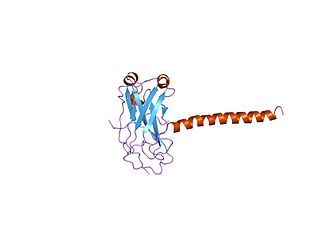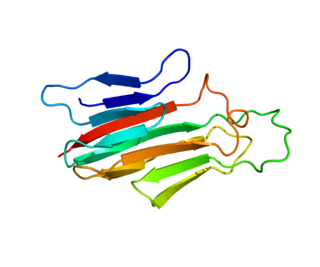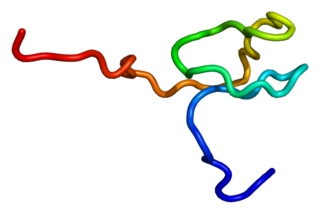Complement C1q tumor necrosis factor-related protein 1 is a protein that in humans is encoded by the C1QTNF1 gene. [5] [6]
Complement C1q tumor necrosis factor-related protein 1 is a protein that in humans is encoded by the C1QTNF1 gene. [5] [6]
C1QTNF1 has been shown to interact with Arginine vasopressin receptor 2. [7]

CD30, also known as TNFRSF8, is a cell membrane protein of the tumor necrosis factor receptor family and tumor marker.

Vasopressin receptor 2 (V2R), or arginine vasopressin receptor 2, is a protein that acts as receptor for vasopressin. AVPR2 belongs to the subfamily of G-protein-coupled receptors. Its activity is mediated by the Gs type of G proteins, which stimulate adenylate cyclase.

The gastric inhibitory polypeptide receptor (GIP-R), also known as the glucose-dependent insulinotropic polypeptide receptor, is a protein that in humans is encoded by the GIPR gene. GIP-R is a member of the 7-transmembrane protein family, a class of G protein coupled receptors. GIP-R is found on beta-cells in the pancreas where it serves as the receptor for the hormone Gastric inhibitory polypeptide (GIP).

CD137 is a member of the tumor necrosis factor (TNF) receptor family. Its alternative names are tumor necrosis factor receptor superfamily member 9 (TNFRSF9), 4-1BB and induced by lymphocyte activation (ILA). It is of interest to immunologists as a co-stimulatory immune checkpoint molecule.

TNF receptor-associated factor 2 is a protein that in humans is encoded by the TRAF2 gene.

Tumor necrosis factor receptor 1 (TNFR1), also known as tumor necrosis factor receptor superfamily member 1A (TNFRSF1A) and CD120a, is a ubiquitous membrane receptor that binds tumor necrosis factor-alpha (TNFα).

TNF receptor-associated factor 1 is a protein that in humans is encoded by the TRAF1 gene.

Pituitary adenylate cyclase-activating polypeptide type I receptor also known as PAC1, is a protein that in humans is encoded by the ADCYAP1R1 gene. This receptor binds pituitary adenylate cyclase activating peptide.

Decoy receptor 3 (Dcr3), also known as tumor necrosis factor receptor superfamily member 6B (TNFRSF6B), TR6 and M68, is a soluble protein of the tumor necrosis factor receptor superfamily which inhibits Fas ligand-induced apoptosis.

Death receptor 3 (DR3), also known as tumor necrosis factor receptor superfamily member 25 (TNFRSF25), is a cell surface receptor of the tumor necrosis factor receptor superfamily which mediates apoptotic signalling and differentiation. Its only known TNFSF ligand is TNF-like protein 1A (TL1A).

TNF receptor-associated factor 4 (TRAF4) also known as RING finger protein 83 (RNF83) is a protein that in humans is encoded by the TRAF4 gene.

TRAF family member-associated NF-kappa-B activator is a protein that in humans is encoded by the TANK gene.

B-cell maturation antigen, also known as tumor necrosis factor receptor superfamily member 17 (TNFRSF17), is a protein that in humans is encoded by the TNFRSF17 gene.

Heat shock protein 75 kDa, mitochondrial is a protein that in humans is encoded by the TRAP1 gene.

Tumor necrosis factor receptor superfamily, member 19, also known as TNFRSF19 and TROY is a human gene.

Tumor necrosis factor ligand superfamily member 18 is a protein that in humans is encoded by the TNFSF18 gene.

C1q and tumor necrosis factor related protein 5, also known as C1QTNF5, is a protein which in humans is encoded by the C1QTNF5 gene. The C1QTNF5 gene secreted and membrane-linked to a protein which is strongly expressed in retinal pigment epithelium cells.

RanBP-type and C3HC4-type zinc finger-containing protein 1 is a protein that in humans is encoded by the RBCK1 gene.

BTB/POZ domain-containing protein TNFAIP1 is a protein that in humans is encoded by the TNFAIP1 gene.

Tumor necrosis factor receptor superfamily member 19L is a protein that in humans is encoded by the RELT gene.